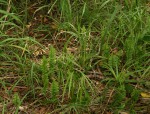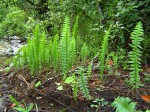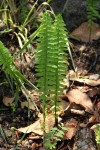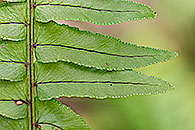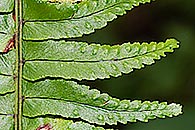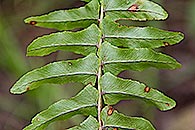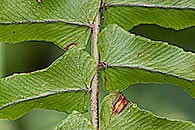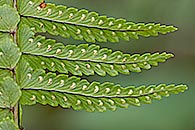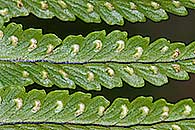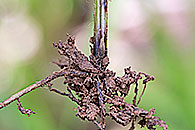Nephrolepis undulata (Afzel.) J. Sm.
Synonyms |
Aspidium undulatum Afzel. ex Sw. |
|---|---|
Common name |
|
Description |
Rhizome short, erect, with long stolons, in places producing elliptical tubers, up to 3 cm long, from which new plants arise. Fronds few (1-3), tufted, erect, herbaceous. Stipe up to 16(-25) cm long, brown, with sparse narrowly lanceolate, entire, brown scales up to 4 mm long, glabrous with age. Lamina up to 100 × 11 cm, narrowly elliptic to lanceolate in outline, pinnate, lower pinnae gradually reduced; pinnae 4.5-5 x 1 cm, sessile, articulated, closely spaced or overlapping, narrowly oblong in outline, base cordate and auricled or lobed on the acroscopic side, overlapping on to the rhachis, apex rounded to pointed, both surfaces glabrous, margins entire or crenate, veins free, ending in an inconspicuous submarginal hydathode; rhachis stramineous to pale brown, glabrous to subglabrous. Sori c. 1.5 mm wide, semi-lunulate, set in a submarginal line along both sides of the pinnae; indusia facing the margin, semi-lunulate, membranous, entire. |
Notes | |
Derivation | undulata: wavy, unclear reference, possibly describing the pinna margins. |
Habitat | Terrestrial along forest margins in montane grassland, in riverine forest, in swampy areas, along seepage lines, in pockets of humus on rocky cliff faces, on termite mounds, or epiphyte in secondary forests or plantations, frequent on the trunks of Elaeis |
Distribution worldwide | Worldwide, widespread in Africa and tropical Central and South America. |
Distribution in Africa |
Angola, Benin, Burkina Fasso, Burundi, Cameroon, Central African Republic, Chad, Congo, Dem. Republic of Congo, Equatorial Guinea (incl. Bioko), Eritrea, Ethiopia, Gabon, Ghana, Guinea, Guinea Bissau, Ivory Coast, Kenya, Liberia, Malawi, Mali, Mozambique, Nigeria, Rwanda, Senegal, Sierra Leone, Sudan and South Sudan, Tanzania , Togo, Uganda, Zambia, Zimbabwe. |
Growth form |
Epiphytic, terrestrial. |
Literature |
|
